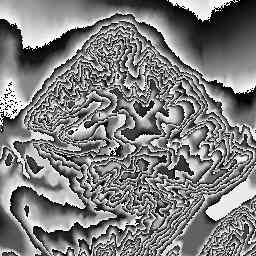
Coherence is a measure of correlation in an interferogram.
Coherence ranges from 0.0, where there is no useful information in the interferogram; to 1.0, where there is no noise in the interferogram (a perfect interferogram). Both extremes are rarely seen-- most images lie somewhere in between.
Coherence is affected by, in approximate order:
Coherence can serve as a measure of the quality of an interferogram; tell you more about the surface type (vegetated vs. rock); or tell you when a tiny, otherwise invisible change has occured in the image.
A British group was actually able to detect the trail of a group of tanks on a British military base by the change in coherence.
Coherence is only visible in the phase image of an interferogram.
High coherence makes for attractive, not-noisy interferograms. Here
is a coherent phase image of a mountain.

Low coherence makes unattractive, noisy interferograms. Often,
these interferograms are difficult to phase unwrap. Here is an incoherent
phase image of a mountain.

Back to interferometry main page
Last Updated: September 1, 1998
If you have any questions, please feel free to email olawlor@acm.org